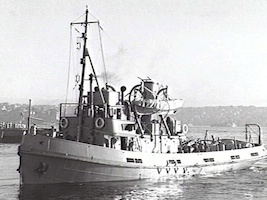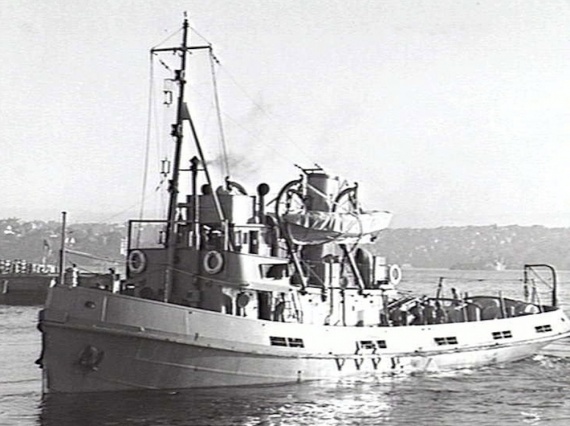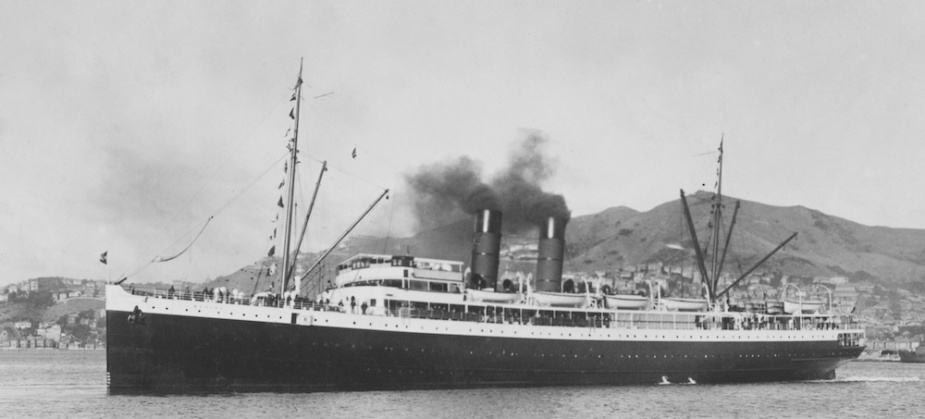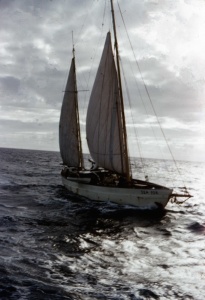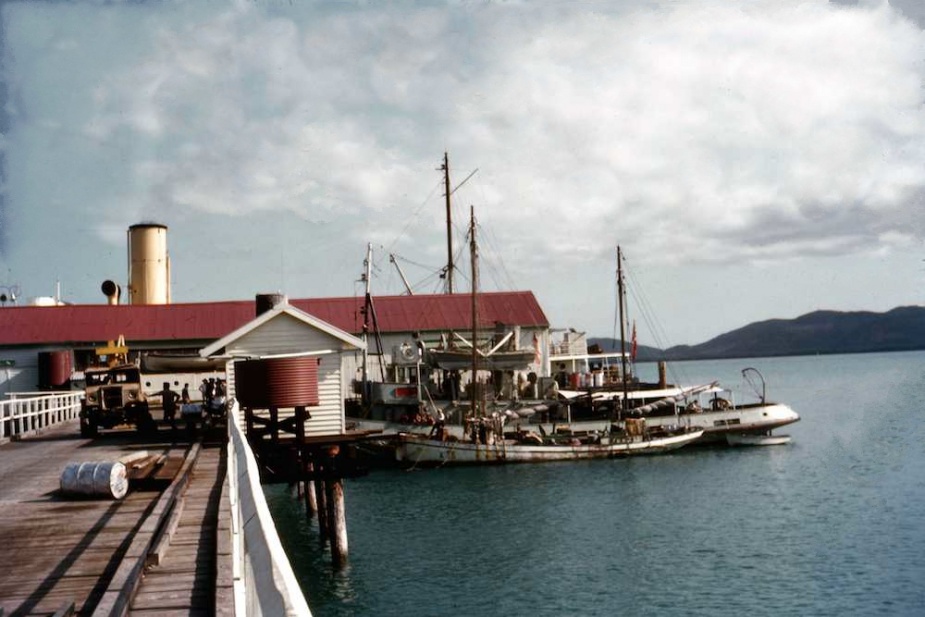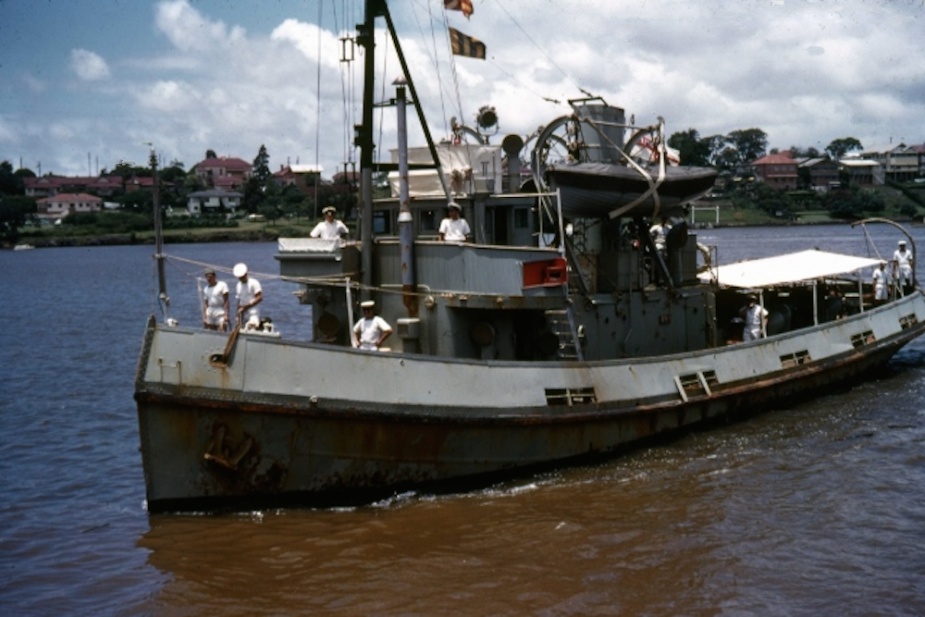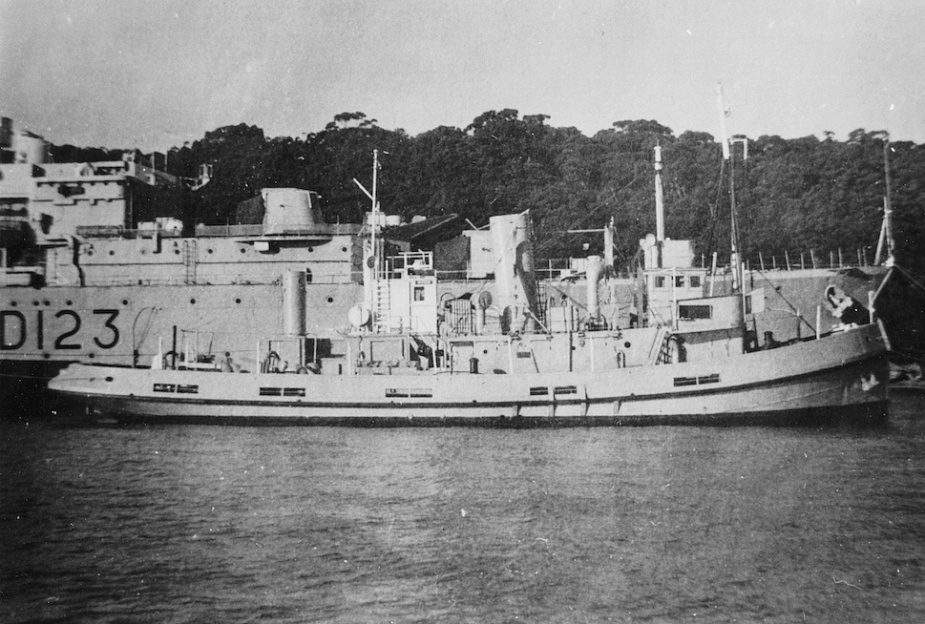HMAS Emu
| Type |
Diesel Tug |
|---|---|
| Pennant |
DT931 |
| Nickname |
Grey Ghost of the North Coast |
| Builder |
Mort's Dock, Sydney |
| Launched |
25 June 1946 |
| Commissioned |
30 July 1946 |
| Decommissioned |
17 December 1959 |
| Fate |
Sold |
| Dimensions & Displacement | |
| Displacement | 250 tons |
| Length | 98 feet 9 inches |
| Beam | 21 feet 3 inches |
| Draught | 8 feet |
| Performance | |
| Speed | 9 knots |
| Complement | |
| Crew | 16 |
| Propulsion | |
| Machinery | Diesel single screw |
| Horsepower | 510 bhp |
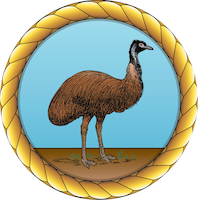
Diesel Tug (DT) 931 commissioned at Sydney on 30 July 1946 under the command of Lieutenant Cyril M Boas, RANR (S). The ship was not officially named Emu until December 1950.
DT 931 arrived in the Darwin area in January 1947 from where she performed various duties including patrol work, air-sea-rescue work and surveillance of Japanese pearling fleet luggers operating in waters north of Australia.
It was rescue and salvage work, however, that Emu is perhaps best remembered for, having been involved scores of individual incidents. These ranged from plucking the crews of capsized sailing dinghies from the waters of Darwin Harbour, to pulling much larger vessels from reefs in and around the Northern Territory.
On 16 August 1951, the 4436 ton New Zealand troopship Wahine, carrying 575 troop reinforcements bound for Korea, grounded on a reef near Masela Island some 250 miles north of Darwin. A passing oil tanker, Stanvac Karachi, rescued the troops and crew, ferrying them safely to Darwin. Left behind, however, was a salvageable cargo, estimated to be worth somewhere between £20,000-£50,000, comprising military equipment and stores.
A few hours after the grounding, Emu’s then captain, Lieutenant Commander John Toulouse, RANVR, flew over Wahine in an RAAF aircraft to assess the situation with a view to establishing whether the vessel might be pulled clear. He observed that almost half of Wahine’s length had passed over the reef, correctly concluding that the ship was lost. The following day Toulouse received orders to proceed to the stricken ship with instructions to recover what equipment he could. Emu’s crew subsequently removed all arms, ammunition, equipment and canteen stores along with 25 percent of the crew’s and troop’s baggage. As Emu left the scene, hundreds of Masela Islanders could be scene descending on the vessel. Following a return visit to the Wahine, Lieutenant Commander Toulouse reported the vessel as being in a desolate state having been systematically looted of all remaining cargo and fittings.
In November 1953 Emu rendered assistance to the 60 ton MV Illawarra, which had grounded on a reef in the Wessel Islands in north eastern Arnhem Land waters. The crew of 12 was rescued and the vessel subsequently refloated and towed by Emu to Jensens Bay, where her cargo was offloaded before being taken to Darwin to effect repairs.
The next significant rescue occurred on 11 March 1957 when Emu received orders to investigate reports of unidentified caucasian men wandering in bushland on Bathurst Island. On arrival in Bowen Bay, Emu’s crew located six survivors from the British treasure ship Gold Seeker who had crossed the Timor Sea in a 16-foot open boat before making landfall. All were in a desperate state and unable to care for themselves necessitating them being carried, one-by-one, in the arms of Lieutenant Commander Toulouse and Sergeant Barrie Tiernan of the Northern Territory Police, back through the surf to Emu’s waiting boat. From there they were repatriated to Darwin.
Arguably, the most curious search and rescue that Emu (Lieutenant MB Rayment, RAN) was involved in occurred in July 1959 when she went to the assistance of the American luxury yacht Sea Fox.
Built in Boston, Massachusetts in 1915, Sea Fox was originally named Thespian before being purchased by Hollywood actor, hypnotist and magician John Calvert, in 1957. Calvert had the vessel fitted out so that he could take his stage show of hypnotism and magic on a world tour, beginning in South East Asia. In 1959 Calvert and his entourage sailed in Sea Fox to begin a tour of Australia, starting in Darwin. On arrival his presence made an immediate impact in the town. Emu’s then Executive Officer, Sub Lieutenant (later Commodore) WSG Bateman, RAN, takes up the story:
I first saw the Sea Fox in Darwin in mid-June 1959, shortly after she had arrived there after a six week passage from Singapore. Onboard were John Calvert, Pilita Corrales, an attractive young Spanish-Philippine singing star, a chimpanzee named Jimmy, alias Cheetah of the Tarzan film series, and a crew of five, who also doubled as Calvert’s stage assistants.
At first the local Darwin press and population were enthralled by the visit. Although Darwin is a regular port of call for cruising yachts, especially during the dry season, not for many years had a yacht so large visited the port. Apart from the size of the vessel, onboard was a top-line hypnotist and magician who promised to give Darwin the best live entertainment ever seen there.
However, it transpired that all was not well in Sea Fox and, for reasons known only to them, her disgruntled crew gave up the vessel necessitating Calvert to advertise for a replacement. With a new crew of dubious ability secured, the vessel sailed from Darwin on Tuesday 30 June 1959, bound for Sydney. On 5 July a Methodist Mission at Elcho Island in Arnhem Land picked up a dramatic distress call from the charismatic Calvert, reporting that Sea Fox was taking water and in dire need of assistance. Although explicit details of the crew’s plight were relayed, oddly no position was included in that transmission. A two day search by aircraft of the RAAF failed to find any trace of the vessel and it was only after a subsequent transmission from Calvert was received that her position was established as being approximately sixty miles north of Cape Wessel.
Throughout the search Calvert refused to condone a general call for assistance going out to all shipping in the area and this behaviour raised some suspicion concerning the ‘missing’ vessel. In spite of this the search continued and Emu was made ready to render assistance if required. A breakthrough came on 8 July when a RAAF Lincoln aircraft reported that the yacht had been sighted in the Arafura Sea. Emu subsequently proceeded to the scene, sighting the vessel at 07:30 on the morning of 9 July.
Emu’s captain boarded the Sea Fox shortly after arriving on the scene finding the yacht in a deplorable condition and leaking badly. Sails were hoisted but poorly set and tattered and torn in places, and elsewhere damage to the vessels rigging was evident. The crew appeared exhausted and dissatisfied, having been employed almost continually for the previous four days hand baling water from the vessel following the failure of the yacht’s power-driven pump.
Emu’s crew quickly set to work repairing the pump and began baling out the water while Lieutenant Rayment and Calvert entered into discussions concerning the yacht’s future. After considerable debate it was recommended that Sea Fox should proceed to Elcho Island where its seaworthiness could be assessed. However, Calvert was adamant that he wished proceed to Thursday Island and, after receiving fuel and water from Emu, he attempted to do so. Emu’s prescient Captain remained in company with Sea Fox which proved fortunate as the vessel was shortly in need of further assistance when it again stopped. This settled the matter of destination and a course was consequently set for Elcho Island.
Over the next 24 hours little progress was made, and Calvert repeatedly refused to accept a tow line due to concerns over salvage rights. Faced with worsening weather he reluctantly acquiesced on this point, but only after Emu’s Captain supplied a written guarantee that no salvage claim would be made. Finally a tow was passed at 11:15 on 11 July and the two vessels reached the mission station at Elcho Island at 16:00 on Sunday 12 July. Sub Lieutenant Bateman continues the story:
There the tow was slipped at the request of the yacht’s master to save the Sea Fox the indignity of being towed into port. An hour or so later both vessels were snugly at anchor and a magnificent press conference to tell the saga of the Sea Fox began ashore. The staff of the Methodist Mission on Elcho Island excelled themselves mightily in the hospitality extended to their unexpected guests.
Meanwhile Sea Fox was pumped dry and prepared for careening on the beach to enable her hull to be assessed for damage the following morning. That evolution did not proceed according to plan, and the yacht was further damaged following a misunderstanding between the coxswain of a launch holding the vessel upright and Calvert. Sea Fox suddenly rolled heavily over onto one side sustaining further damage, and this ultimately spelt the end for the once fine vessel. Sub Lieutenant Bateman recorded:
Now the protagonists of the Sea Fox gradually left Elcho Island to go their separate ways. HMAS Emu returned to her fishery surveillance duties with the Japanese pearling fleet, and John Calvert and his crew returned by air to Darwin.
With everybody else gone their different ways, it now appeared likely that Elcho Island Mission Station had won itself the gift of a luxuriously appointed yacht, although she was far from being in prime condition and a doubtful asset at that.
The operation to locate Calvert and his crew was estimated to have cost £30,000. This drew the attention of both the then Minister for Shipping and the Minister for the Navy after they learnt of allegations made by one on Sea Fox’s crew members that the ordeal had been a publicity stunt orchestrated by Calvert. This was never proven.
Later Sea Fox was made temporarily seaworthy and taken back to Darwin by Mr Carl Atkinson, who having secured for himself a vague salvage contract from Calvert, flew to Elcho Island to take possession of the yacht. The voyage back to Darwin proved a nightmare for Atkinson due to poor weather and the deteriorating condition of the vessel. He eventually made it into port where Sea Fox was beached in Doctor’s Gully. There she remained for many years, falling into decay before eventually being sold and scrapped by her new owners for her lead ballast. The remains of the once proud vessels were burnt. John Calvert faired much better than his yacht, passing away at age 102 on 27 September 2013.
On 16 November 1959 HMAS Emu left Darwin for Sydney, having completed 13 years of continuous service in northern Australian waters.
The Naval Officer in Charge reported that on her final departure from Darwin, Emu made a brave picture steaming out of the harbour with her paying off pennant streaming in the breeze.
After calling at Cairns and Brisbane en route, Emu arrived at Sydney on 14 December 1959, paying off into Reserve on 17 December. On 2 May 1967 the tug was sold to James Louis Pty Ltd, 290 Botany Road, Alexandria, NSW. In 1970 it was reported that the ex-Emu was employed in a commercial capacity in northern Australian waters, operating under the name Tenax.

